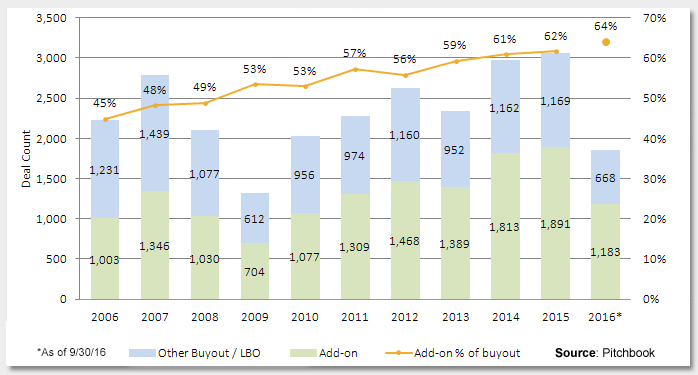In previous posts, I have discussed the rising valuations and increased use of equity to finance deals in the U.S. private equity markets. This week’s chart shows yet another trend that has emerged as valuations continue to rise. Add-on acquisitions have been on an upward trajectory since approximately 2006 and have reached a decade high as a percent of buyout transactions, reaching 64% in 2016.
When private equity sponsors pursue consolidation strategies, generally they will acquire a platform company that will house management, infrastructure and systems and then look to add-on acquisitions. These add-ons are typically smaller companies that the sponsor can roll into the platform and gain accretive revenue, scale and synergies, ultimately creating a larger company that is of interest to potential acquirers. Add-ons often lack scale, systems and sophisticated management themselves, all factors that allow them to trade at a discount to larger targets.
U.S. merger and acquisition (M&A) valuations are continuing on an upward trajectory. According to Pitchbook, valuation multiples hit 11.2x enterprise value (EV) / EBITDA1 year-to-date as of September 30, up from 10.2x in 2015 and 8.5x in 2010. In an attempt to lower the purchase price sponsors pay for companies, they have looked to add-ons as an attractive way to average down their entry multiples and grow their portfolio companies. To provide some perspective, global deal multiples in the second quarter of 2016 show the valuation multiple discount as it relates to a company’s enterprise value. According to Pitchbook, companies under $25 million in EV traded at 6.1x (EV / EBITDA), companies between $25 million to $250 million traded at 8.2x and companies over $250 million were at 9.8x. Over the last couple of years, we have seen sponsors target younger and less mature companies in an effort to find less efficient parts of the market. In traditional private equity, institutional capital has been targeting companies under $100 million in EV to find value. In the venture capital markets, it is institutional capital moving into early stage and even seed funding rounds. This search for value is not a free lunch. These add-ons pose unique challenges including integration risks, lack of infrastructure, key person dependencies, customer concentration and limited financial flexibility, to name a few.
Key Takeaway: Given the search for value, capital has moved to earlier stage and less developed companies both in the venture capital and private equity markets. Managers with experience navigating the unique challenges of what are often subscale assets will have ample opportunity to sell into what has become a very competitive market.
1EV = Enterprise Value
EBITDA = Earnings Before Interest Depreciation and Amortization
The material provided here is for informational use only. The views expressed are those of the author, and do not necessarily reflect the views of Penn Mutual Asset Management.
This material is for informational use only. The views expressed are those of the author, and do not necessarily reflect the views of Penn Mutual Asset Management. This material is not intended to be relied upon as a forecast, research or investment advice, and it is not a recommendation, offer or solicitation to buy or sell any securities or to adopt any investment strategy.
Opinions and statements of financial market trends that are based on current market conditions constitute judgment of the author and are subject to change without notice. The information and opinions contained in this material are derived from sources deemed to be reliable but should not be assumed to be accurate or complete. Statements that reflect projections or expectations of future financial or economic performance of the markets may be considered forward-looking statements. Actual results may differ significantly. Any forecasts contained in this material are based on various estimates and assumptions, and there can be no assurance that such estimates or assumptions will prove accurate.
Investing involves risk, including possible loss of principal. Past performance is no guarantee of future results. All information referenced in preparation of this material has been obtained from sources believed to be reliable, but accuracy and completeness are not guaranteed. There is no representation or warranty as to the accuracy of the information and Penn Mutual Asset Management shall have no liability for decisions based upon such information.
High-Yield bonds are subject to greater fluctuations in value and risk of loss of income and principal. Investing in higher yielding, lower rated corporate bonds have a greater risk of price fluctuations and loss of principal and income than U.S. Treasury bonds and bills. Government securities offer a higher degree of safety and are guaranteed as to the timely payment of principal and interest if held to maturity.
All trademarks are the property of their respective owners. This material may not be reproduced in whole or in part in any form, or referred to in any other publication, without express written permission.


